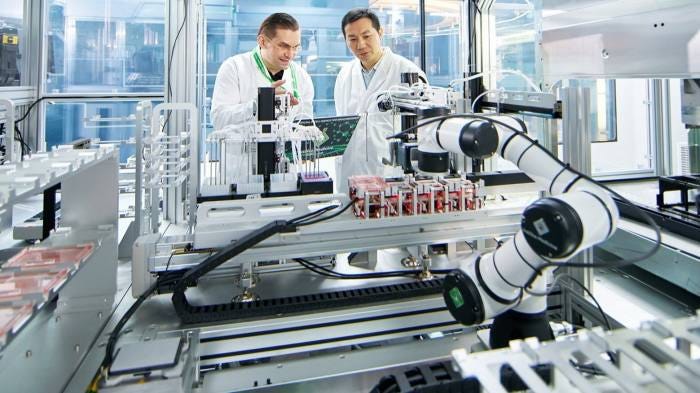Funding Fury & Deja vu, AI Designed Protein, and more ...
The Intelli-Science Monthly, July 2023
You never know when or where AI and Science would converge
§1. Machine Learning and Intelligent Systems
1/ 1Yr → $4Bn?! AIGC Funding Space Remains Red-hot & Controversial
AI startup Inflection, led by former DeepMind executive Mustafa Suleyman, raised $1.3 billion in new funding just months after launching chatbot Pi. The round, led by Microsoft, Nvidia, and billionaires like Reid Hoffman and Bill Gates, values Inflection at $4 billion. How much of the round is cash vs. compute credit is unknown and has raised controversy.
Inflection claims it now has the world's most powerful AI computing infrastructure with over 20,000 Nvidia GPUs, aided by partnerships with Microsoft and Nvidia. Suleyman says Inflection will keep expanding its capabilities to develop bigger AI models, raising billions more despite critics arguing such large models are unnecessary, harmful, and environmentally damaging. Inflection believes massive scale is required to lead the "tidal wave" of AI, but its voracious growth and funding has sparked debate on AI funding.
[Curator’s Note]
It should be noted that using compute credit as investment is neither rare nor “bad” per se. It does reminded me though, of a discussion approx. 10 yr ago when VCs first started to realise that 60 cent of every dollar they put in a startup ends up in the pocket of AWS, Facebook and Google for hosting service, ads etc. This prompted a question for LPs — if the money ends up in big tech anyway, why not just put money in NASDAQ? And indeed, that would have been a pretty good strategy, as NASAQ had performed better than average VC funds’ DPI
In addition, I have tried the Chatbot Pi and found it fascinating. Was it more powerful than GPT-4? Not at all. But how it’s designed is quite interesting: it always start its response with an acknowledgement of what you said, the ends with a followup question and don’t rush to give you an answer. Was this necessarily good? idk, but it does feel easier to have longer conversation with Pi than GPT, and that has value for sure. Whether that value is worth $4bn is another issue …

Berkeley-based KoBold Metals, which leverages artificial intelligence to guide mineral exploration, raised $200 million in a funding round valuing the company at over $1 billion. The round was led by T. Rowe Price and included Bill Gates' Breakthrough Energy Ventures, Andreessen Horowitz, and others. KoBold combines clean energy and AI, two hot investment areas, to improve the efficiency of discovering critical battery metals like copper and lithium. It uses machine learning to analyze geological data and identify high-potential spots to explore. The funds will accelerate efforts to secure materials needed for electrification, as demand outpaces supply. While skeptical at first, mining giants like BHP now partner with KoBold, recognizing that remaining deposits are deeper underground and harder to find with traditional techniques. KoBold aims to transform mineral exploration with a scientific, tech-driven approach to mining.
3/ AI-copyright debate heats up
A growing group of artists, writers, and filmmakers argue AI chatbots like ChatGPT and image generators were illegally trained on their copyrighted work without consent or compensation. Recent lawsuits against AI companies allege violations of copyright law. While the tech firms claim fair use protections, critics say scraping creative content to train AI models is unethical and harms artists' livelihoods. Lawmakers, social media platforms, and entertainment unions are siding with creators demanding more transparency and control over use of their content in AI training data. Possible remedies include licenses, filters to prevent copying, or curated datasets. The battle poses a major threat to adoption of AI systems that tech giants argue are an innovation on par with the mobile phone. Resolution may require changing how AI data collection works to address rights and consent issues.
China announced comprehensive new rules governing generative AI like ChatGPT, to be overseen by its top internet regulator. The regulations require adherence to social values and ban illegal uses. Developers must register algorithms and undergo security reviews, extending existing controls. Exempted are research AI and systems for foreign use, hinting at global ambitions. The rules offer a potential model for AI governance, including intellectual property protections and privacy safeguards. They arrive amid an AI race with the US, as China sees the technology as an economic priority. With encouragement for global rule-setting participation, China may advocate its regulatory approach internationally. The broad regulations demonstrate the country's intent to rapidly adopt AI across industries, but also firmly embed government oversight. China's assertive stance makes AIGC regulation an emerging frontier in great power technological competition.
§2. Advancement in Science
5/ Superconductor Research Remains Heated
The recent discovery of pressure-induced superconductivity above 80K in the nickelate La3Ni2O7, as reported in Nature on July 12th, 2023, represents a major breakthrough for high temperature superconductivity research. After 36 years, scientists seem to have finally found a second family of unconventional superconductors beyond copper oxides that can exceed the liquid nitrogen temperature of 77K, rekindling hopes of unraveling the mechanism and enabling applications of high temperature superconductivity. Despite the many obstacles faced, including theoretical challenges and practical limitations of existing materials, persistent explorations by scientists worldwide have uncovered new superconducting systems like iron-based compounds previously. The latest finding in nickelates, enabled by high pressure techniques, offers a new platform to investigate unconventional superconductivity. Further discoveries in this system may lead to higher transition temperatures or properties better suited for applications. The eternal allure of superconductivity continues to drive human ingenuity in materials science and condensed matter physics.
§3. Developments in AI for Science
6/ AI yields designer proteins

World renowed computational biologist David Baker’s team published a new AI program RFdiffusion, which allows researchers to generate novel proteins tailored for specific functions, similar to how Midjourey/DALL-E/StableDiffusion produces images from text prompts. Scientists can upload a 3D model of a biological molecule like a cell receptor. RFdiffusion can then predict protein sequences and structures likely to interact with the target, providing promising candidates to test as therapies or for other applications. In evaluations, RFdiffusion increased accuracy up to 100 times compared to previous protein design programs not using AI. This new AI-powered approach could assist researchers in designing proteins for goals such as extracting metals from seawater or removing carbon dioxide from the air. By leveraging AI to predict optimal protein structures, RFdiffusion aims to accelerate discovery of proteins useful for medicine, environmental remediation, and more.
7/ World Economic Forum Taking Notice of AI for Science

Here are the key points by Joris Poort, CEO of Rescale, writing on WEF’s platform:
AI is transforming fields like engineering and scientific computing to redefine innovation across industries. Computer simulations increasingly use AI to understand how different product designs will perform.
AI can make R&D more efficient by reducing the need for expensive and time-consuming physical simulations. Machine learning models can be trained on simulation data to quickly predict how new designs will perform.
AI-physics models capture engineering best practices and expertise that can be retained within an organization. This brings greater agility to develop new prototypes and enter new markets faster.
Generative design AI tools can come up with innovative product designs that engineers may not have conceived of on their own. This can lead to new and unconventional product shapes and forms.
Organizations need to establish best practices to ensure they navigate the AI transition safely. This includes reviewing AI outputs for accuracy and ethics, securing IP, and providing the right training data.
With appropriate safeguards, AI can accelerate engineering innovation, scientific discovery, and the development of breakthrough products and designs. Supporting AI physics will help create better products faster.
8/ AI-designed drug enters human trials

Biotech company Insilico Medicine has started a phase 2 human trial testing a drug for idiopathic pulmonary fibrosis that was discovered and designed entirely by artificial intelligence. This marks a significant milestone as one of the first mid-stage trials of an AI-generated therapy. Insilico founder Alex Zhavoronkov claims the company's AI platforms can dramatically accelerate drug discovery and slash development costs. The generative AI rapidly identifies novel targets and designs molecule compounds. While AI's potential in drug development is still developing, pharma companies have invested billions in partnerships with AI startups like Insilico seeking to capitalize on potential cost and time savings. Critics caution AI's promise may be overhyped. But success for Insilico's self-developed drug candidate could pave the way for AI end-to-end across the pharma R&D process.
9/ New AI Weather Prediction Published on Nature
Two new AI models detailed in Nature could significantly improve weather forecasting speed and extreme weather predictions. Huawei's Pangu-Weather uses deep learning to analyze all weather variables simultaneously, generating forecasts in seconds versus hours for traditional methods, with comparable accuracy. Pangu-Weather accurately predicted tropical cyclone paths despite no training data on them, showing AI's ability to generalize physics. Separately, NowcastNet leverages physics-based generative AI to forecast extreme rainfall further in advance than other leading systems. While questions remain on real-world performance, AI offers major potential to complement conventional forecasting and provide more advance warning for extreme weather events. However, AI may underestimate event intensity, and climate change poses challenges. Overall, AI looks set to transform meteorology, but human expertise will still be critical.
One more thing …
10/ Biotech Company’s Stock Surge 78% on Nvidia’s $50M Investment
We covered Recursion on the June Issue of Intelli-Science Monthly when it acquired two smaller companies in the AI Drug Discovery space. Recently Nvidia maked a PIPE investment in Recursion, which prompted its stock to surge over 78% in one day. AI for (Life) Science is a multi-layered industry with players on hardware, fundemental model, specialised model, data, data infra, application etc. As the industry develops during its infant stage, collaborations and consolidations activities will likely to remain vibrant.





